Italeri 1/72 Spitfire Mk Vb
|
KIT #: |
001 |
|
PRICE: |
7.50 Euro |
|
DECALS: |
Four options |
|
REVIEWER: |
Carmel
J. Attard |
|
NOTES: |
Pavla decals and parts set # 1240; 12 Euros.
Provides two decal options. |
Spitfire Mk Vbs action history by two
Malta
air war aces
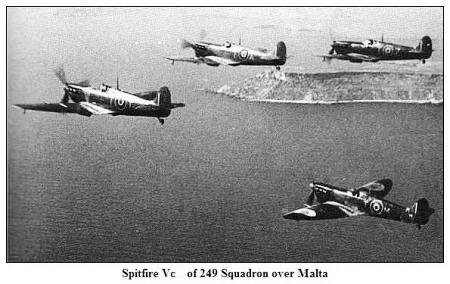 A
lot of useful information has already been reiterated about the Spitfire and its
evolution into several successful types including the Spitfire MkVb. Instead of
going once more into details of how the MkVb came about it is worth going into
some detail about the airmen who flew the type in particular to Spitfires MkVb
EP706 and EP340. The airman was no other than the Canadian born daring and
legendary pilots, George F Beurling and JF McElroy who with their courage and
actions against the enemy during the air war over
Malta
were to become a legends.
A
lot of useful information has already been reiterated about the Spitfire and its
evolution into several successful types including the Spitfire MkVb. Instead of
going once more into details of how the MkVb came about it is worth going into
some detail about the airmen who flew the type in particular to Spitfires MkVb
EP706 and EP340. The airman was no other than the Canadian born daring and
legendary pilots, George F Beurling and JF McElroy who with their courage and
actions against the enemy during the air war over
Malta
were to become a legends.
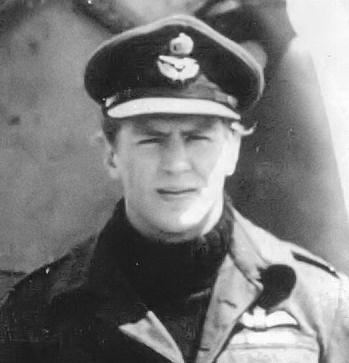 George
Beurling became the top scoring fighter pilot in
Malta.
Nicknamed as ‘Screwball’, George F Beurling was a superb pilot to become a
legend in
Malta.
He arrived in
Malta
during June 1942 in particular attachment to No 249 (Gold Coast) squadron, which
was to bring out the best of him. This changed the impression he created of
himself from a non-conformant to rules and regulations, when it came to
authority into an examplainatory top scorer pilot.
George Beurling applied to join the RCAF in 1940 but he lacked
educational qualification to enroll him for pilot training. He soon worked his
passage to
Britain
and joined the RAF where he was accepted for aircrew training. Although
sometimes undisciplined he passed his flying training with no problems and was
soon in the thick of fighting. He gained two early victories but was severely
reprimanded for breaking away from the accepted formation pattern. It seemed
that he was hell bent on shooting down every enemy aircraft himself no matter
what method he used. This of course did not please his superiors who regarded
him as somewhat reckless. Being sent to serve overseas was with the hope to
conform where with 249 Squadron he was to become a hero.
George
Beurling became the top scoring fighter pilot in
Malta.
Nicknamed as ‘Screwball’, George F Beurling was a superb pilot to become a
legend in
Malta.
He arrived in
Malta
during June 1942 in particular attachment to No 249 (Gold Coast) squadron, which
was to bring out the best of him. This changed the impression he created of
himself from a non-conformant to rules and regulations, when it came to
authority into an examplainatory top scorer pilot.
George Beurling applied to join the RCAF in 1940 but he lacked
educational qualification to enroll him for pilot training. He soon worked his
passage to
Britain
and joined the RAF where he was accepted for aircrew training. Although
sometimes undisciplined he passed his flying training with no problems and was
soon in the thick of fighting. He gained two early victories but was severely
reprimanded for breaking away from the accepted formation pattern. It seemed
that he was hell bent on shooting down every enemy aircraft himself no matter
what method he used. This of course did not please his superiors who regarded
him as somewhat reckless. Being sent to serve overseas was with the hope to
conform where with 249 Squadron he was to become a hero.
Being
manned by a large proportion of Commonwealth personnel 249 Sq adopted the name
of ‘Gold Coast’; the squadron was assigned with defensive patrol flying from
Church Fenton, Boscombe Down and North Weald through 1940-41 flying Hurricane I.
In February 1941 the Squadron re-equipped with Hurricane II and was notified of
a posting to
Malta.
These embarked on aircraft carriers HMS Furious and HMS Ark Royal and after a
rough voyage flew the aircraft on
the 21st
of May 1941
to Ta’Qali airfield, which is located close to the town of
Mosta..
From the
dark days of 1940 when the island of Malta was defended by three Gloster Sea
Gladiators, successive convoys to Malta were able to deliver aircraft
successfully though with some loss, forming a superior number of fighters able
to defend Malta and sister island of Gozo and also begin to carry the fight back
to the enemy stationed in Italy. No 249 converted from Hurricane to Spitfire Vb,
and later to Spitfire Vc with a great number of very good pilots flying within
its fold. In early 1942 the aircraft carrier
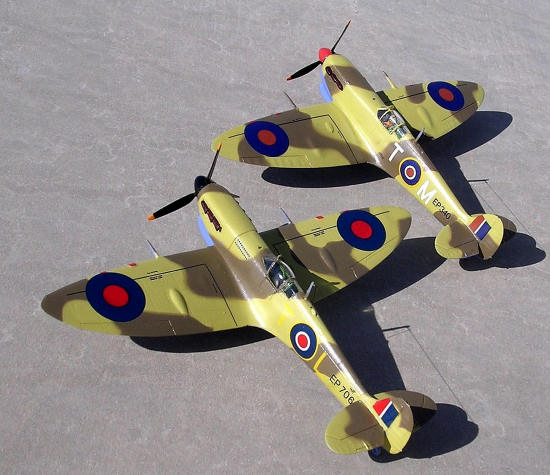 HMS
Eagle was bound for
Malta
from
Gibraltar
in operation ‘Salient’ carrying 30 Spitfires to strengthen the island’s fighting
force. All 30 reached
Malta
on the 9th of June and included within the ranks was Sgt George
Beurling being accepted in the squadron as an exceptional pilot even though a
crazy one. Settling at Ta’ Qali with the new squadron it took three days for
Beurling for his first score in
Malta.
This happened when a force of Messerschmitt Bf 109s came over shortly after dawn
in hope of catching the airfield by surprise. Being alerted by the radar station
at Had Dingli, Beurling and the squadron scrambled to intercept the incoming
fighter wave. His first service score on the island was when he destroyed one of
the enemy aircraft. July brought an onslaught by axis planes and bringing fear
of possible surrender of
Malta.
Junkers Ju 88s of II and
III/KG77
and Bf 109sof I/KG77 were moved to Sicily from the Russian front and together
with units from Regia Aeronautica, the new offensive begun. On 6th
July, a fine and clear day mass raids over
Malta
began in full force and every fighter from Ta’Qali and Hal-Luqa airfields
scrambled to meet the enemy. Eight Spitfires from 249 Sq encountered a large
force of bombers with fighter escort when still over Gozo. Beurling managed to
shoot down a Macchi 202 and minutes later shot down another.. Landing to refuel
and rearm he shot down a Bf 109and damaged a Cant Z1007. On 27th July
Beurling had an even grater success, claiming two Macchis and two Bf 109s. and
two more damaged. One more Macchi was shot down with 4 machine guns after his
cannon jammed. The following day Sgt Beurling’s award of DFM came through.. The
relentless onslaught by enemy by the enemy continued and by August the kill
score approached 16, a unique achievement in such a short time.
HMS
Eagle was bound for
Malta
from
Gibraltar
in operation ‘Salient’ carrying 30 Spitfires to strengthen the island’s fighting
force. All 30 reached
Malta
on the 9th of June and included within the ranks was Sgt George
Beurling being accepted in the squadron as an exceptional pilot even though a
crazy one. Settling at Ta’ Qali with the new squadron it took three days for
Beurling for his first score in
Malta.
This happened when a force of Messerschmitt Bf 109s came over shortly after dawn
in hope of catching the airfield by surprise. Being alerted by the radar station
at Had Dingli, Beurling and the squadron scrambled to intercept the incoming
fighter wave. His first service score on the island was when he destroyed one of
the enemy aircraft. July brought an onslaught by axis planes and bringing fear
of possible surrender of
Malta.
Junkers Ju 88s of II and
III/KG77
and Bf 109sof I/KG77 were moved to Sicily from the Russian front and together
with units from Regia Aeronautica, the new offensive begun. On 6th
July, a fine and clear day mass raids over
Malta
began in full force and every fighter from Ta’Qali and Hal-Luqa airfields
scrambled to meet the enemy. Eight Spitfires from 249 Sq encountered a large
force of bombers with fighter escort when still over Gozo. Beurling managed to
shoot down a Macchi 202 and minutes later shot down another.. Landing to refuel
and rearm he shot down a Bf 109and damaged a Cant Z1007. On 27th July
Beurling had an even grater success, claiming two Macchis and two Bf 109s. and
two more damaged. One more Macchi was shot down with 4 machine guns after his
cannon jammed. The following day Sgt Beurling’s award of DFM came through.. The
relentless onslaught by enemy by the enemy continued and by August the kill
score approached 16, a unique achievement in such a short time.
During a
well-known convoy code named “Pedestal” for Malta that was to relieve the siege
like suffering conditions to both civilian and military people on the island the
enemy launched more and massive attacks, day and night. This resulted that only
5 of the original 14 ships that left
Gibraltar
made it, one of which was the oil carrying tanker “Ohio”.
Operation “Pedestal” gave pilot officer Beurling more kills. On 4th
September he was awarded a Bar to DFM. September and October brought his score
to 26. He seemed invincible and to many other pilots on the island, he was
becoming a legend. On
14th
October 1942
the radar at Had Dingli plotted a force of 8 Ju 88 with an escort of 50 Bf 109s.
Approaching the island 249 Sq scrambled and met the enemy off Gozo coastline.
Beurling immediately weaved amongst the bombers and promptly shot one down.
Pulling up to attack the fighters he fired at a 109, which also went down.
During the process a burst sent from one Ju 88 across the Spitfire cockpit hit
his 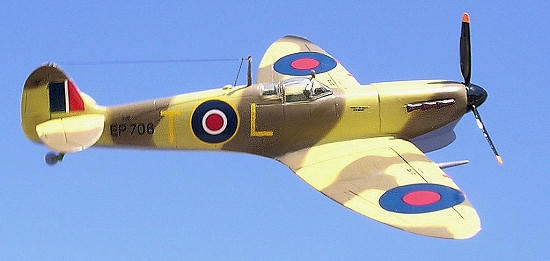 hands
and forearm. Beurling put the
Spitfire into a dive in order to get clear and return to base and soon noticed a
fellow pilot being chased by a Bf 109. He maneuvered the aircraft round and
fired his guns into the belly of the 109. Unfortunately an unseen 109 also had
Beurling in his sight and raked his aircraft with cannon fire. The Spitfire fell
out of control hitting Beurling his legs and heels. Despite his injuries he
managed to bale out and was picked up by a high Speed Launch 128, which was
already on the way having watched his Spitfire fall and the parachute open. He
gently splashed down over
St Paul’s
Bay. As he was being pulled aboard Beurling expressed concern that he could not
find a Bible that his mother has given him. He carried it on every sortie and
was sure that it brought him good luck. It was eventually found and with a sigh
of relief he fell into a deep sleep.
hands
and forearm. Beurling put the
Spitfire into a dive in order to get clear and return to base and soon noticed a
fellow pilot being chased by a Bf 109. He maneuvered the aircraft round and
fired his guns into the belly of the 109. Unfortunately an unseen 109 also had
Beurling in his sight and raked his aircraft with cannon fire. The Spitfire fell
out of control hitting Beurling his legs and heels. Despite his injuries he
managed to bale out and was picked up by a high Speed Launch 128, which was
already on the way having watched his Spitfire fall and the parachute open. He
gently splashed down over
St Paul’s
Bay. As he was being pulled aboard Beurling expressed concern that he could not
find a Bible that his mother has given him. He carried it on every sortie and
was sure that it brought him good luck. It was eventually found and with a sigh
of relief he fell into a deep sleep.
Recovering
from the L-Imtarfa Military hospital he reluctantly received the news that his
tour of
Malta
was over. Despite the award of
DFC
and a month later a DSO he felt rejected and sad that he was to leave his
beloved
Malta.
In November he left
Malta
for
UK
in a Liberator and upon approaching
Gibraltar
the aircraft crashed in the sea but Beurling survived.
In
Malta
he was accredited with 27 1/3 victories while with 249 Sq. at Ta’ Qali making
him the highest scoring allied pilot on the island. He eventually added two more
kills to his total before finally being killed in 1948 whilst delivering an
aircraft to
Israel.
A small corner of the
National
War
Museum
at
Fort St
Elmo,
Valletta,
his memory is forever engraved. He was indeed, one of the greatest pilot heroes
of the war and of
Malta.
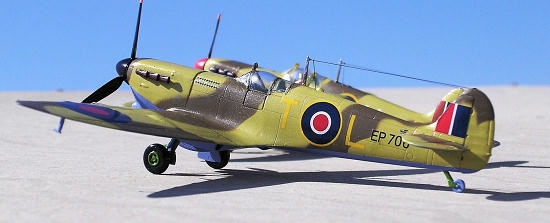 The
Italeri kit appears to be a reissue of earlier MkIX kit 094 but with obvious
changes to make a MkVb mainly concentrating to the underwing detail, tropical
filter, exhaust stacks and armament.. Beautifully molded in grey styrene the
MkVb has fine panel lines detail some of the panels are raised. There is a
detailed cockpit interiors and wheel wells and well fitting parts making it a
joy in building the model. An addition attraction is that the kit has parts for
a Mediterranean version having the large cumbersome Vokes tropical filter
immediately under the nose for an aircraft flown by 249 Sq and again two
different filters as used on a 244 RAF Wing and355th FS USAAC fighter group. It
was an obvious choice to construct the MkVb flown by Flying Officer George
Beurling in view of his connections with the island who flew the aircraft barely
a mile away from where I live.
The
Italeri kit appears to be a reissue of earlier MkIX kit 094 but with obvious
changes to make a MkVb mainly concentrating to the underwing detail, tropical
filter, exhaust stacks and armament.. Beautifully molded in grey styrene the
MkVb has fine panel lines detail some of the panels are raised. There is a
detailed cockpit interiors and wheel wells and well fitting parts making it a
joy in building the model. An addition attraction is that the kit has parts for
a Mediterranean version having the large cumbersome Vokes tropical filter
immediately under the nose for an aircraft flown by 249 Sq and again two
different filters as used on a 244 RAF Wing and355th FS USAAC fighter group. It
was an obvious choice to construct the MkVb flown by Flying Officer George
Beurling in view of his connections with the island who flew the aircraft barely
a mile away from where I live.
There are no
difficult parts to fit together and construction was straightforward starting
with the cockpit office in grey/green finish with brown seats and black and
white instruments. Only the seat belts need to add. Care was taken not to spoil
the fine depressed panel lines during construction and the joint lines were good
match with practically no filler needed. Along with this kit I also had the
Pavla Spitfire detail set No1240 which provided a choice for a belly tank,
Tropical filter etc and decal options, all of which I have used on this kit. The
cockpit was already crammed with detail and though this lacked side panel detail
the cockpit
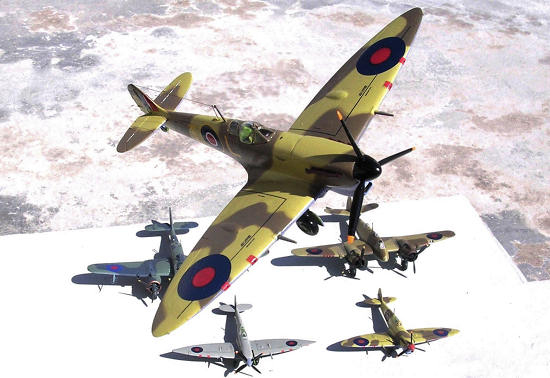 was to
be closed and I found no scope to add more detail here. Care was taken to join
the separate three bladed propeller at the correct pitch angle to ensure they
are assembled at a right hand rotation as indicated on the instructions. There
are two types of wind screens and optional rear view mirrors and the
instructions indicate which type can be used while the view mirrors is left to
adequate reference material.
was to
be closed and I found no scope to add more detail here. Care was taken to join
the separate three bladed propeller at the correct pitch angle to ensure they
are assembled at a right hand rotation as indicated on the instructions. There
are two types of wind screens and optional rear view mirrors and the
instructions indicate which type can be used while the view mirrors is left to
adequate reference material.
Another
Spitfire VB was built alongside the Beurling Spitfire which was EP340 coded T-M.
This had identical camouflage pattern of light and dark earth with the
difference that the colors are reversed as shown in the pictures. Spitfire Vb
was flown by another ace in the
Battle
for
Malta.
The decals issued in the same Pavla set No 1240 mentioned earlier are those for
the Spitfire flown by flying officer John McElroy who was also serving with
No249 Sq based at the same airfield at Ta’Qali. With this Spitfire McElroy
destroyed a Reggiani Re2001 and damaged a Bf 109 on
the 13th
October 1942.
JF
McElroy was another famous pilot flying with 249 Squadron, and was two times an
ace. He became a squadron leader after the war. In 1948 the fledging air force
of the new state of
Israel
raised a single fighter squadron No 101, which was soon equipped with Spitfire
IX, acquired from various sources. In the brief war with Arab neighbors the unit
was to claim some 35 victories. The most successful being Rudi Avergarten, a
former
US
P-47 pilot who claimed three and one shared including two Egyptian Spitfires IX.
The
Malta
ace, Canadian JF McElroy who has claimed 8 or 9 over the hard-pressed island,
added three more and one shared with 2nd TAF. After the war ended he
fought in the
Middle East
shooting down an Egyptian Fiat G55 at the end of December 1948. McElroy then
added further Spitfire victories on
Jan 7th
1949
by shooting down two RAF Spitfires XVIII of 208 Squadron.
Among the three decal
options that comes with the kit of the MkVb there is one attached to Sq No249
RAF based at Ta’Qali (wrongly printed as TAKALI), Malta in 1942 but the decal
had incorrect white letter codes instead of yellow and here is where Pavla came
to t he
rescue which are provided in yellow. Decals for the two Spitfire ace markings
both came from the Pavla set. These were of the usual high quality and those for
EP706 also carried the tally kill markings added to port side of cockpit. I used
Humbrol paints mid stone and dark earth for the upper camouflage and azure blue
CA15 Compucolor brand for the undersides. A fine XF needle fitted to my Badger
150 brought the correct feathered edge between the colors.
he
rescue which are provided in yellow. Decals for the two Spitfire ace markings
both came from the Pavla set. These were of the usual high quality and those for
EP706 also carried the tally kill markings added to port side of cockpit. I used
Humbrol paints mid stone and dark earth for the upper camouflage and azure blue
CA15 Compucolor brand for the undersides. A fine XF needle fitted to my Badger
150 brought the correct feathered edge between the colors.
The Italeri kit has
nice fitting detail parts, which easily be enhanced further with Pavla kit pack.
If you build one MkVb you go for a second one like I did. The interesting about
the pilots who flew the type is that F/L GF Beurling DSO
DFC
DFM had 31.3 victories to rank third in the top scorer list of British WWII
combat pilots, while S/L JF McElroy is No27 on the same rank list of 97 aces. An
’ace ‘ in this case is termed as a pilot claiming five or more victories on
Spitfires. Everyone in Malta very well knew these two outstanding Ace pilots
besides other gallant airmen based here during the bitter years of WWII.
1)
‘Flypast’ December 1985 issue
2)
‘ Malta Flypast’ issue No8.
Carmel J.
Attard
August 2010If you would like your product reviewed fairly and quickly, please
contact
me or see other details in the
Note to
Contributors.
Back to the Main Page
Back to the Review
Index Page
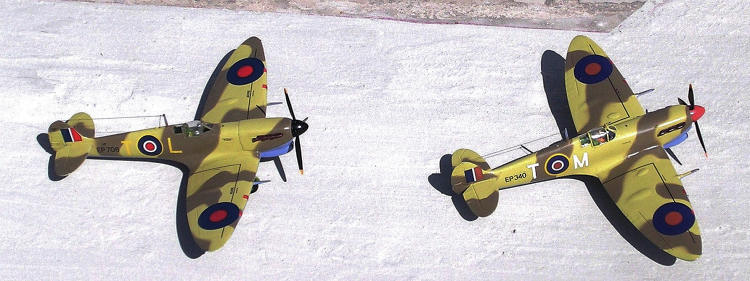



 HMS
Eagle was bound for
HMS
Eagle was bound for  hands
and forearm. Beurling put the
Spitfire into a dive in order to get clear and return to base and soon noticed a
fellow pilot being chased by a Bf 109. He maneuvered the aircraft round and
fired his guns into the belly of the 109. Unfortunately an unseen 109 also had
Beurling in his sight and raked his aircraft with cannon fire. The Spitfire fell
out of control hitting Beurling his legs and heels. Despite his injuries he
managed to bale out and was picked up by a high Speed Launch 128, which was
already on the way having watched his Spitfire fall and the parachute open. He
gently splashed down over
hands
and forearm. Beurling put the
Spitfire into a dive in order to get clear and return to base and soon noticed a
fellow pilot being chased by a Bf 109. He maneuvered the aircraft round and
fired his guns into the belly of the 109. Unfortunately an unseen 109 also had
Beurling in his sight and raked his aircraft with cannon fire. The Spitfire fell
out of control hitting Beurling his legs and heels. Despite his injuries he
managed to bale out and was picked up by a high Speed Launch 128, which was
already on the way having watched his Spitfire fall and the parachute open. He
gently splashed down over  The
Italeri kit appears to be a reissue of earlier MkIX kit 094 but with obvious
changes to make a MkVb mainly concentrating to the underwing detail, tropical
filter, exhaust stacks and armament.. Beautifully molded in grey styrene the
MkVb has fine panel lines detail some of the panels are raised. There is a
detailed cockpit interiors and wheel wells and well fitting parts making it a
joy in building the model. An addition attraction is that the kit has parts for
a Mediterranean version having the large cumbersome Vokes tropical filter
immediately under the nose for an aircraft flown by 249 Sq and again two
different filters as used on a 244 RAF Wing and355th FS USAAC fighter group. It
was an obvious choice to construct the MkVb flown by Flying Officer George
Beurling in view of his connections with the island who flew the aircraft barely
a mile away from where I live.
The
Italeri kit appears to be a reissue of earlier MkIX kit 094 but with obvious
changes to make a MkVb mainly concentrating to the underwing detail, tropical
filter, exhaust stacks and armament.. Beautifully molded in grey styrene the
MkVb has fine panel lines detail some of the panels are raised. There is a
detailed cockpit interiors and wheel wells and well fitting parts making it a
joy in building the model. An addition attraction is that the kit has parts for
a Mediterranean version having the large cumbersome Vokes tropical filter
immediately under the nose for an aircraft flown by 249 Sq and again two
different filters as used on a 244 RAF Wing and355th FS USAAC fighter group. It
was an obvious choice to construct the MkVb flown by Flying Officer George
Beurling in view of his connections with the island who flew the aircraft barely
a mile away from where I live. was to
be closed and I found no scope to add more detail here. Care was taken to join
the separate three bladed propeller at the correct pitch angle to ensure they
are assembled at a right hand rotation as indicated on the instructions. There
are two types of wind screens and optional rear view mirrors and the
instructions indicate which type can be used while the view mirrors is left to
adequate reference material.
was to
be closed and I found no scope to add more detail here. Care was taken to join
the separate three bladed propeller at the correct pitch angle to ensure they
are assembled at a right hand rotation as indicated on the instructions. There
are two types of wind screens and optional rear view mirrors and the
instructions indicate which type can be used while the view mirrors is left to
adequate reference material. he
rescue which are provided in yellow. Decals for the two Spitfire ace markings
both came from the Pavla set. These were of the usual high quality and those for
EP706 also carried the tally kill markings added to port side of cockpit. I used
Humbrol paints mid stone and dark earth for the upper camouflage and azure blue
CA15 Compucolor brand for the undersides. A fine XF needle fitted to my Badger
150 brought the correct feathered edge between the colors.
he
rescue which are provided in yellow. Decals for the two Spitfire ace markings
both came from the Pavla set. These were of the usual high quality and those for
EP706 also carried the tally kill markings added to port side of cockpit. I used
Humbrol paints mid stone and dark earth for the upper camouflage and azure blue
CA15 Compucolor brand for the undersides. A fine XF needle fitted to my Badger
150 brought the correct feathered edge between the colors.